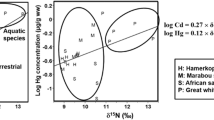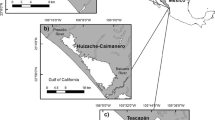Abstract
Heavy metals and organochlorine contamination were analyzed in tissues of red foxes (Vulpes vulpes) from the Province of Siena (central Italy). Mercury (Hg), cadmium (Cd) and lead (Pb) concentrations were assessed in liver tissues and the data were analyzed for differences in relation to sex and age. Overall Hg, Cd and Pb mean values were 0.16, 0.62 and 0.64 μg g_1 d.w., respectively. HCB, DDT and PCB concentrations were assayed in fatty tissues and muscle. The highest levels of those pollutants were found in muscle (0.47, 1.16 and 20.2 μg g_1 lipid basis of HCB, DDTs and PCBs respectively), rather than in fat (0.23, 0.49 and 7.2 μg g_1 l.b. of HCB, DDTs and PCBs respectively). Pollutant accumulation was analyzed in relation to sex, age and sexual maturity of females.
Similar content being viewed by others
References
Adriano, D. C.: 1986, Trace Elements in the Terrestrial Environment, SpringerVerlag, New York.
Cavallini, P. and Santini, S.: 1995, ‘Timing of reproduction in the red fox Vulpes vulpes’, Z. F. Sängetierkunde 60, 337.
Cavallini, P. and Lovari, S.: 1991, ‘Environmental factors influencing the use of habitat in the red fox, Vulpes vulpes’, J. Zool. Lond. 223, 323.
Ciampalini, B. and Lovari, S.: 1985, ‘Food habits and trophic niche overlap of the badger Meles meles L. and the red fox Vulpes vulpes L. in aMediterranean coastal area’, Zeitschrift f¨ür Säugetierkunde 50, 226.
Doncaster, C. P. and Macdonald, D. W.: 1991, ‘Ecology and ranging behaviour of red foxes in the city of Oxford’, Hystrix 3, 11.
Focardi, S., Marsili, L., Fabbri, F. and Carlini, R.: 1990, ‘Preliminary study of chlorinated hydrocarbon levels in Cetacea stranded along the Tyrrhenian coast of Latium (Central Italy)’, European Research on Cetaceans 4, 108.
Hernandez, L. M., Gonzalez, M. J., Rico, M.C., Fernandez, M. A. and Baluja, G.: 1985, ‘Presence and biomagnification of organochlorine pollutants and heavy metals in mammals of Donana National Park (Spain), 1982-1983’, J. Environ. Sci. Health 20, 633.
Hewson, R. and Kolb, H. H.: 1975, ‘The food of foxes (Vulpes vulpes) in Scottish forests’, J. Zool. London 176, 287.
Hopkin, S. P.: 1989, Ecophysiology of metals in terrestrial invertebrates, Pollution monitoring series, Elsevier, London, UK.
Hutton, M. and Symon, C.: 1987, ‘Sources of Cadmium Discharge to the UK Environment’, in: Coughtrey, P. J., Martin, M. H. and Unsworth, M. H. (eds.), Pollutant Transport and Fate in the Ecosystems, pp. 223–237.
Lindström, E.: 1981, ‘Reliability of placental scar counts in the red fox (Vulpes vulpes L.) with special reference to fading of the scars’, Mammal Review 11, 137.
Lovari S., Cavallini P., Crema G., Lazzeretti L., Lucherini, M., Ricci-Lucchi, M. and Valier, P.: 1991, ‘Environmental variables and the use of habitat of the red Fox Vulpes vulpes (L. 1758) in the Maremma Natural Park, Grosseto province, central Italy’, Hystrix 3, 21.
Lovari, S., Valier, P. and Ricci-Lucchi, M.: 1994, ‘Ranging behaviour and activity of the red fox in relation to environmental variables, in a Mediterranean mixed pinewood’, J. Zool. London 232, 323.
Macdonald, D.W., Boitani, L. and Barasso, P.: 1980, ‘Foxes, woives and conservation in the Abruzzo mountains’, Biogeographica 18, 223.
Macdonald, D. W.: 1983, ‘The ecology of carnivore social behaviour’, Nature 301, 379.
Mason, C. F., Ford, T. C. and Last, N. I.: 1986, ‘Organochlorine residues in British Otters’, Bull. Environ. Contam. Toxicol. 36, 656.
Masse, R., Martineau, D., Tremblay, L. and Beland, P.: 1986, ‘Concentrations and chromatographic profile of DDTmetabolites and PCB residues in stranded Beluga Whales (Delphinapterus leucas) from the St. Lawrence Estuary, Canada’, Arch. Environ. Contam. Toxicol. 15, 567.
McIntosh, D. L.: 1963, ‘Food of the red fox in the Canberra district’, Wildlife Res. 8, 1.
Muir, D.C.G., Wagemann, R., Grift, N. P., Norstrom, R. J., Simon, M. and Lien, J.: 1988, ‘Organochlorine chemical and heavy metal contaminants in whitebeaked dolphins (Lagenorhinchus albirostris) and pilot whales (Globicephala melaena) from the coast of Newfoundland, Canada’ Arch. Environ. Contam. Toxicol. 17, 613.
Norheim, G.: 1978, ‘The composition and distribution of PCB in Artic Fox (Alopex lagopus), caught near Longyearbyen on Svalbard’, Acta Pharmacol. Toxicol. 42, 7.
Norheim, G., Skaare, J. U. and Wiig, O.: 1992, ‘Some heavy metals, essential elements, and chlorinated hydrocarbons in polar bear (Ursus maritimus) at Svalbard’, Environ. Pollut. 77, 51.
Nriagu, J. O.: 1990, ‘The rise and fall of leaded gasoline’, Sci. Total Environ. 92, 13.
Prigioni C. and Tacchi F.: 1991, ‘Nicchia trofica della volpe (Vulpes vulpes) nella valle del Ticino’, Hystrix 3, 65.
Saunders, G., White, C. L., Harris, S. and Rayner, M. V.: 1993, ‘Urban foxes Vulpes vulpes: Food acquisition, time and energy budgeting of a generalized predator’, Symp. Zool. Soc. London 65, 215.
Stoeppler, M. and Backaus, F.: 1978, ‘Pretreatment studies with biological and environmental materials. Systems for pressurised multi-sample decomposition’, Fresenius Z. Anal. Chem. 291, 116.
Subramanian, A. N., Tanabe, S. and Tatsukawa R.: 1988, ‘Use of organochlorines as chemical tracers in determining some reproductive parameters in Dalli-type Dall's porpoise Phocenoides dalli’, Mar. Environ. Res. 25, 161.
Tanabe, S., Miura, S. and Tatsukawa, R.: 1986, ‘Variation in organochlorine residues with age and sex in antartic minke whale’, Mem. Natl. Inst. Polar Res. 44, 174.
Tanabe, S., Tanaka, H., Maruyama, K. and Tatsukawa, R.: 1981, ‘Ecology and Bioaccumulation of Stenella coeruleoalba: Elimination of Chlorinated Hydrocarbons from Mother Striped Dolphins (Stenella coeruleoalba) through Parturition and Lactation’, in: Fujiyama, T. (ed.), Studies on the Levels of Organochlorine Compounds and Heavy Metals in the Marine Organisms. Report for the physical year of 1980, Grantinaid for Scientific Research, University of Ryukyius, Okinawa, Japan, pp. 115–121.
Tanabe, S., Watanabe, S., Khan, H. and Tatsukawa, R.: 1988, ‘Capacity andmode of PCBmetabolism in small cetaceans’, Mar. Mammal Sci. 4, 103.
Von Schantz, T.: 1980, ‘Prey consumption of a red fox population in Southern Sweden’, Biogeographica 18, 53.
Wang-Andersen, G., Skaare, J. U., Prestrud, P. and Steinnes, E.: 1993, ‘Levels and congener pattern of PCBs in arctic fox, Alopex lagopus, in Svalbard’, Environ. Pollut. 82, 269.
Watanabe, S., Shimada, T., Nakamura, S., Nishiyama, N., Yamashita, N., Tanabe, S. and Tatsukawa, R.: 1989, ‘Specific profile of liver microsomal cytochrome P-450 in dolphin and whale’, Mar. Environ. Res. 27, 51.
Author information
Authors and Affiliations
Rights and permissions
About this article
Cite this article
Corsolini, S., Focardi, S., Leonzio, C. et al. Heavy Metals and Chlorinated Hydrocarbon Concentrations in the Red Fox in Relation to Some Biological Paramaters. Environ Monit Assess 54, 87–100 (1999). https://doi.org/10.1023/A:1005974014029
Issue Date:
DOI: https://doi.org/10.1023/A:1005974014029




